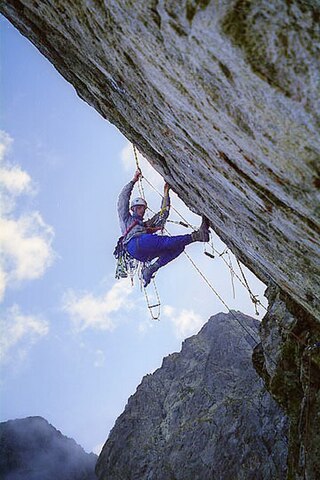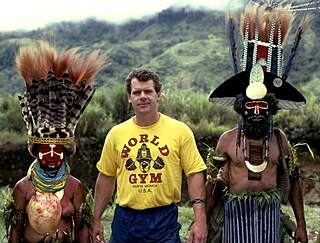
Half Dome is a quartz monzonite batholith at the eastern end of Yosemite Valley in Yosemite National Park, California. It is a well-known rock formation in the park, named for its distinct shape. One side is a sheer face while the other three sides are smooth and round, making it appear like a dome cut in half. It stands at nearly 8,800 feet above sea level and is composed of quartz monzonite, an igneous rock that solidified several thousand feet within the Earth. At its core are the remains of a magma chamber that cooled slowly and crystallized beneath the Earth's surface. The solidified magma chamber was then exposed and cut in half by erosion, therefore leading to the geographic name Half Dome.

Aid climbing is a form of rock climbing that uses mechanical devices and equipment, such as aiders, for upward momentum. Aid climbing is contrasted with free climbing, which only uses mechanical equipment for protection, but not to assist in upward momentum. Aid climbing can involve hammering in permanent pitons and bolts, into which the aiders are clipped, but there is also 'clean aid climbing' which avoids any hammering, and only uses removable placements.

The Trango Towers are a family of rock towers situated in the Gilgit-Baltistan region, in the northern part of Pakistan. The Towers have some of the world's largest cliffs and offer some of the most challenging big wall climbing opportunities. Each year, climbers from around the world embark on expeditions to the Karakoram region to climb these granite faces. The Trango Towers are situated to the north of the Baltoro Glacier and are part of the Baltoro Muztagh, which is a sub-range within the Karakoram mountain range. The highest point within the group is the summit of Great Trango Tower at 6,286 m (20,623 ft), the east face of which features the world's greatest nearly vertical drop.

Royal Robbins was one of the pioneers of American rock climbing. After learning to climb at Tahquitz Rock, he went on to make first ascents of many big wall routes in Yosemite. As an early proponent of boltless, pitonless clean climbing, he, along with Yvon Chouinard, was instrumental in changing the climbing culture of the late 1960s and early 1970s by encouraging the use and preservation of the natural features of the rock. He went on to become a well-known kayaker.

Warren Harding was one of the most accomplished and influential American big wall climbers and aid climbers of the 1950s to 1970s. He was the leader of the first team to climb El Capitan, Yosemite Valley, in 1958. The route they climbed, known as The Nose, ascends 2,900 feet (880 m) up the central buttress of what is one of the largest granite monoliths in the world. Harding made many first ascents in Yosemite, some 28 in all, including The Wall of Early Morning Light.

Jim Bridwell was an American rock climber and mountaineer, active from 1965 in Yosemite Valley, but later in Patagonia and Alaska. He was noted for pushing the standards of both aid climbing and big wall climbing, and later alpine climbing. He wrote numerous articles on climbing and developed several important pieces of aid climbing equipment. Bridwell was an apprentice to Royal Robbins and Warren Harding, and later the unofficial leader of the Stonemasters.

A portaledge is a deployable hanging tent system designed for rock climbers who need to spend multiple days and nights on a climbing route suspended from a sheer rock face while big wall climbing. A fully assembled portaledge is a fabric-covered platform surrounded by a metal frame that hangs from a single anchor point via carabiners and has adjustable suspension straps. A separate cover—called a stormfly—covers the entire system to give protection in the event of bad weather. The first portaledges were created for climbing in Yosemite.

John Long is an American rock climber and author. His stories have been translated into many languages.

In the history of rock climbing, the three main sub-disciplines – bouldering, single-pitch climbing, and big wall climbing – can trace their origins to late 19th-century Europe. Bouldering started in Fontainebleau, and was advanced by Pierre Allain in the 1930s, and John Gill in the 1950s. Big wall climbing started in the Dolomites, and was spread across the Alps in the 1930s by climbers such as Emilio Comici and Riccardo Cassin, and in the 1950s by Walter Bonatti, before reaching Yosemite where it was led in the 1950s to 1970s by climbers such as Royal Robbins. Single-pitch climbing started pre-1900 in both the Lake District and in Saxony, and by the late-1970s had spread widely with climbers such as Ron Fawcett (Britain), Bernd Arnold (Germany), Patrick Berhault (France), Ron Kauk and John Bachar (USA).
Robert John Slater was an American mountaineer known for his first ascent of the big wall route Wyoming Sheep Ranch on El Capitan. An avid outdoor recreationalist, Slater made notable climbs during his college years and later as he worked as a trader on the Chicago Board of Trade and for Goldman Sachs. He died on August 13, 1995, while descending from the summit of K2.
Wojciech Kurtyka is a Polish mountaineer and rock climber, one of the pioneers of the alpine style of climbing the biggest walls in the Greater Ranges. He lived in Wrocław up to 1974 when he moved to Kraków. He graduated as engineer in electronics. In 1985 he climbed the "Shining Wall," the west face of Gasherbrum IV, which Climbing magazine declared to be the greatest achievement of mountaineering in the twentieth century. In 2016, he received the Piolet d'Or for lifetime achievement in mountaineering.
Greg Child is an Australian-born rock climber, mountaineer, author and filmmaker.

Stephanie "Steph" Davis is an American rock climber, BASE jumper, and wingsuit flyer. She is one of the world's leading climbers, having completed some of the hardest routes in the world. She has free soloed up to 5.11a (6b+), and was the first woman to summit all the peaks of the Fitzroy Range in Patagonia, the second woman to free climb El Capitan in a day, the first woman to free climb the Salathė Wall on El Capitan, the first woman to free solo The Diamond on Longs Peak in Colorado, and the first woman to summit Torre Egger. Davis was married to fellow climbers and BASE jumpers Dean Potter and Mario Richard, and currently to sky-diving instructor, flyer, and jumper Ian Mitchard. Davis is also a blogger who writes about her interests in climbing, BASE jumping, yoga, and veganism.

Big wall climbing is a form of rock climbing that takes place on long multi-pitch routes that normally require a full day, if not several days, to ascend. In addition, big wall routes are typically sustained and exposed where the climbers remain continuously suspended from a vertical rock face, even sleeping hanging from the face, with limited options to sit down or escape unless they abseil down the route—a complex and risky action. It is therefore a physically and mentally demanding form of climbing.

The Nose is a big wall climbing route up El Capitan. Once considered impossible to climb, El Capitan is now the standard for big wall climbing. It is recognized in the historic climbing text Fifty Classic Climbs of North America and considered a classic around the world.

Thomas "Tom" M. Frost was an American rock climber known for big wall climbing first ascents in Yosemite Valley. He was also a photographer and climbing equipment manufacturer. Frost was born in Hollywood, California, and died in Oakdale, California.

Charles Marshall Pratt was an American rock climber known for big wall climbing first ascents in Yosemite Valley. He was also a long-time climbing instructor and mountain guide with Exum Mountain Guides in the Grand Tetons.

Alex Honnold is an American rock climber best known for his free solo ascents of big walls. Honnold rose to worldwide fame in June 2017 when he became the first person to free solo a full route on El Capitan in Yosemite National Park, a climb described in The New York Times as "one of the great athletic feats of any kind, ever." Honnold also holds the record for the fastest ascent of the "Yosemite Triple Crown", an 18-hour, 50-minute link-up of Mount Watkins, The Nose, and the Regular Northwest Face of Half Dome. In 2015, he won a Piolet d'Or in alpine climbing with Tommy Caldwell for their completion of the enchainment of the Cerro Chaltén Group in Patagonia over 5 days.

In climbing and mountaineering, a traverse is a section of a climbing route where the climber moves laterally, as opposed to in an upward direction. The term has broad application, and its use can range from describing a brief section of lateral movement on a pitch of a climbing route, to large multi-pitch climbing routes that almost entirely consist of lateral movement such as girdle traverses that span the entire rock face of a crag, to mountain traverses that span entire ridges connecting chains of mountain peaks.

















